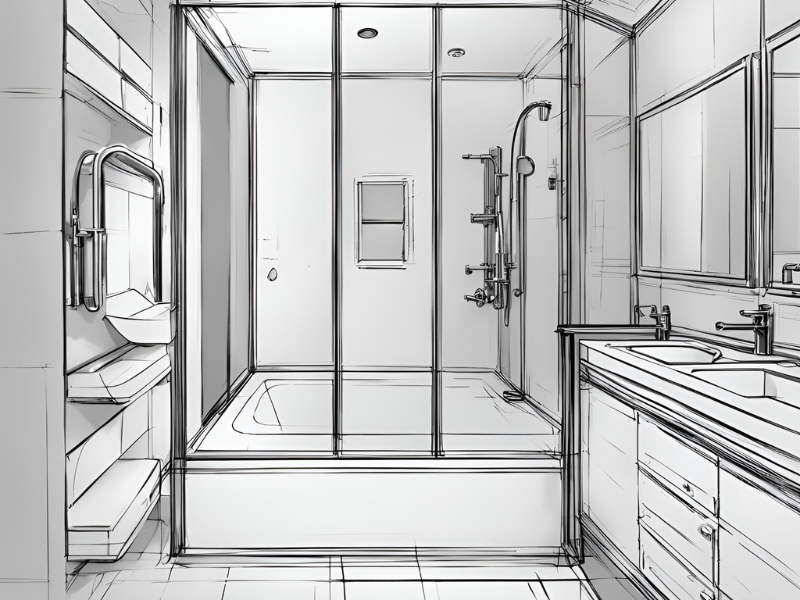Bathroom shop drawings play a pivotal role in the successful execution of construction projects, particularly in the realm of interior design and architecture.
These detailed drawings serve as the blueprint for the layout, configuration, and installation of bathroom fixtures and components within a building or structure.
The placement of sinks and toilets to the intricacies of plumbing and electrical systems, and bathroom shop drawings provide a comprehensive guide for contractors, installers, and other stakeholders involved in the construction process.
They serve as a communication tool, facilitating collaboration between designers, engineers, contractors, and clients to ensure that the final outcome aligns with the envisioned design while meeting functional requirements and regulatory standards.
Here are the process of bathroom shop drawings.
Understanding the Components of Bathroom Shop Drawings
Bathroom shop drawings are comprehensive documents that encompass various elements crucial for the successful installation and construction of bathrooms within a building.
These drawings provide detailed information about the layout, dimensions, fixtures, materials, and systems involved, ensuring clarity and precision in the execution of the design.
Here are the key components typically found in bathroom shop drawings:
1. Floor Plan: The floor plan is a top-down view of the bathroom layout, illustrating the spatial arrangement of fixtures, walls, doors, and other architectural features.
2. Elevations: Elevations depict the vertical views of walls, fixtures, and cabinetry within the bathroom. They provide essential information about the height, placement, and configuration of elements such as sinks, toilets, showers, bathtubs, mirrors, and storage units.
3. Sections: Sections are detailed views that cut through the bathroom space vertically or horizontally, revealing the internal structure, plumbing lines, electrical wiring, and other hidden components.
4. Fixture Details: Each fixture within the bathroom, including sinks, toilets, showers, and bathtubs, is accompanied by specific details in the shop drawings.
5. Plumbing Layout: The plumbing layout outlines the configuration of pipes, drains, vents, and supply lines necessary for the functioning of water supply and drainage systems in the bathroom.
6. Electrical Plan: The electrical plan specifies the location of outlets, switches, light fixtures, exhaust fans, and other electrical components within the bathroom.
7. Material Specifications: Bathroom shop drawings often include specifications for materials and finishes used in various components, such as tiles, countertops, cabinetry, hardware, and plumbing fixtures.
8. Annotations and Dimensions: Annotations, symbols, and dimensions are essential for conveying important information and measurements within the drawings.
Preparing for Bathroom Shop Drawings
Before embarking on the creation of bathroom shop drawings, thorough preparation is essential to ensure accuracy, efficiency, and alignment with client expectations and project requirements.
Here’s a detailed overview of the preparations involved:
1. Initial Consultation and Client Requirements: Engage in an initial consultation with the client to understand their preferences, needs, and specific requirements for the bathroom design.
2. Site Assessment and Measurements: Conduct a thorough site assessment to gather accurate measurements and dimensions of the existing bathroom space or the designated area for construction.
3. Collaboration with Architects, Engineers, and Designers: Collaborate closely with architects, structural engineers, mechanical engineers, and interior designers involved in the project to ensure alignment of the bathroom design with the overall building plan.
4. Gathering Necessary Information and Specifications: Collect relevant information and specifications for fixtures, materials, finishes, and building codes applicable to the project.
5. Documentation and Record-Keeping: Maintain comprehensive documentation of all communications, agreements, and decisions made during the pre-drawing phase.
Creating Bathroom Shop Drawings
The process of creating bathroom shop drawings involves translating conceptual designs and client requirements into detailed, technical drawings that serve as the blueprint for construction and installation.
Here’s a step-by-step guide to creating bathroom shop drawings:
1. Selection of Design Software and Tools: Choose appropriate design software and drafting tools suited for creating detailed architectural drawings. Popular software options include AutoCAD, Revit, SketchUp, and Adobe Illustrator.
2. Drafting Layouts and Floor Plans: Begin by drafting the floor plan layout of the bathroom, accurately depicting the spatial arrangement of fixtures, walls, doors, and other architectural elements.
3. Incorporating Plumbing and Electrical Layouts: Integrate the plumbing and electrical layouts into the bathroom shop drawings, indicating the placement of pipes, fixtures, outlets, switches, and lighting fixtures.
4. Detailing Fixture Placements and Dimensions: Provide detailed drawings of individual fixtures such as sinks, toilets, showers, bathtubs, and vanities, specifying their dimensions, clearances, and installation requirements.
5. Review and Quality Assurance: Conduct internal reviews and quality checks to verify the accuracy, completeness, and compliance of the bathroom shop drawings with project requirements and industry standards.
Importance of Accuracy and Detail in Bathroom Shop Drawings
The accuracy and level of detail in bathroom shop drawings are paramount for the successful execution of construction projects. These drawings serve as the primary reference for contractors, installers, and other stakeholders involved in the construction process.
Here’s why accuracy and detail are crucial in bathroom shop drawings:
1. Precision in Measurements and Scale: Accurate measurements and scale representation ensure that bathroom fixtures, components, and spatial layouts align with the intended design and architectural plans.
2. Minimizing Errors and Rework: Detailed shop drawings help identify potential conflicts, clashes, or discrepancies in the design early in the planning stages.
3. Facilitating Smooth Installation Process: Contractors and installers rely on accurate shop drawings to understand the exact placement, orientation, and assembly of bathroom fixtures and components.
4. Enhancing Communication and Collaboration: Detailed shop drawings serve as a common reference point for communication and collaboration among architects, designers, engineers, contractors, and clients.
5 Compliance with Building Codes and Regulations: Accurate shop drawings ensure compliance with building codes, zoning regulations, and industry standards governing bathroom design and construction.
Conclusion
In conclusion, bathroom shop drawings are indispensable tools that play a critical role in the successful execution of construction projects. From initial consultations to the final installation, these detailed drawings serve as the backbone of the design and construction process, providing invaluable guidance and clarity for all stakeholders involved.
The importance of accuracy and detail in bathroom shop drawings cannot be overstated. Precision in measurements, clear annotations, and adherence to industry standards are essential for minimizing errors, facilitating smooth installations, and ensuring compliance with building codes and regulations.





